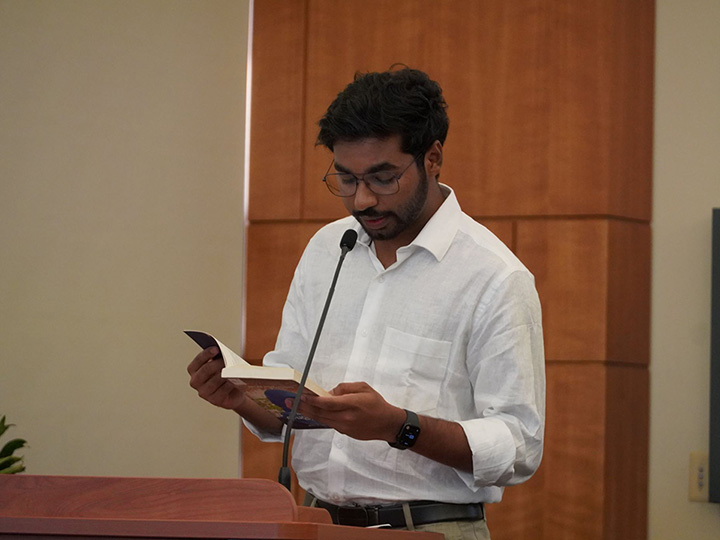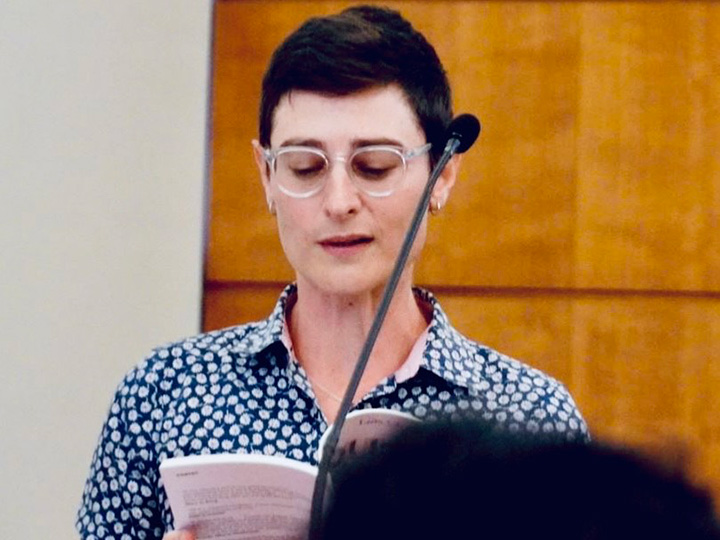

This September, accomplished graduate student and faculty translators convened at the Rockwell Pavilion to participate in panels and readings hosted by The Institute for Global Engagement. The event was an opportunity to celebrate and investigate translation as a form of bridge-building, drawing speakers from Arte Público Press, Hispanic Studies, Communication Sciences, and more.
FORWARD spoke with several translators involved—Dr. Hosam Aboul-Ela and Dr. Kavita Singh, as well as PhD students Julia Guez and Ibrahim Badshah—to learn more about the art, practice, and theory of translation at UH.
Dr. Aboul-Ela, as an organizer of this reading, could you tell us a little about other translation initiatives within the English department, and your current projects?
We have a graduate certificate in translation, and it’s a series of courses and workshops around translation. We have a translation stream within the PhD program. As a result, there are many courses being offered at the graduate level—almost every semester, there’s something related to the theory or the practice or the history of translation, and we have ideas for expanding. Whether you’re a translator, or not a translator, or even monolingual, how does thinking translation improve your toolkit for engaging with the literary? That’s a larger question the discipline of English is confronting. I’m a translator from Arabic, and I’ve translated four novels so far. Most recently I’ve been working on this writer Sonallah Ibrahim. I did a novel of his called Warda that came out in the summer of 2021.
Julia, you’re working on a translation of Costa Rican poet María Montero’s collection La Mano Suicida. As a poet yourself, has working on this translation influenced your own writing?
I’ve been working with a handful of poets and writers from Costa Rica, including María Montero and Luis Chaves. The work that I need to do as a translator in process allows me to bring a similar approach to my own writing: I can be in a flow and then come up to something that I don’t yet have a solution for, insert a placeholder, and come back to it. That was born out of relentless work with other people’s poetry—written in a language other than my own—and the humility that requires. There are frequent moments when I have to sit in not knowing. Being able to bring a similar stance to the creation of my own art has been good. I translate work that sounds really different from the work that I make, and that’s purposeful. I don’t want to in any way impose my sensibility on somebody else’s. My role is to get completely out of the way if I can, and understand their voice. But certain lines—when you spend enough time with them—do stay with you. So I have seen, between Luis Chaves and me, certain tics, or certain techniques enter my form, very subtly. And my sense of repertoire is expanded by that.
Dr. Singh, you participated in a panel about the future of translation at UH. What initiatives are most exciting to you? How does your own research intersect with translation?
I write about multilingualism; I write about Creole and languages in the Caribbean. It’s a classic postcolonial problem: what language do we write in? And because Caribbean languages tend to be languages born of contact between different peoples, there’s this particular fluidity. It’s so wonderful that we have these incredibly accomplished translators within our department. It’s of great value for us that they bring their languages into an English department—and the fact that we’re an English department with so many people working outside of English and thinking across languages is beautiful. I would love it if there were more funding and programs supporting both students and faculty engaged in the study of languages, linguistics, and translation. I was excited to see so many of our colleagues in Hispanic Studies and in Modern & Classical Languages here, and to feel like we can genuinely create these inter-departmental initiatives that allow us to share what we’re doing and trying to create.
Ibrahim, you’ve translated both novels and short stories, working in English, Arabic, and Malayalam. Does your approach to translation change depending on literary form?
I try to think about translation primarily as a political tool, which should be analysed by taking its impact into consideration. I’m trained in postcolonialism, so my understanding of translation has always been in relation to its politics—the violence of translation in the colonial context, how translation was used to manipulate the subject etc. So, I invert the same analytical framework for the purposes of my translation and determine the methodology that I want to follow in terms of the political purposes that it seeks to serve. For example, when I translated this novel about the Naxalite movement in India, I was thinking about how this novel is going to work in the specific context of Kerala, which also has a predominantly leftist political orientation. There, the methodological choices I made are driven by this purpose I have in mind and the effect I wish to create in the readers. This was different when I translated a contemporary Arabic novel into Malayalam, where my choices were determined by my purpose of bringing the lyricism of the writing into the language. While these two can be broadly put into the same form that we can call “novel”, the methodology is wildly different. Therefore, I believe the different methodologies I follow are not on the basis of form, but on the basis of the substance or purpose I see in those projects.